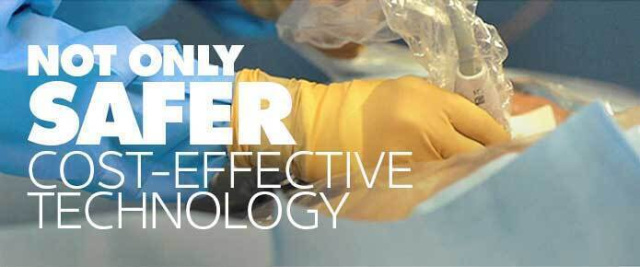The health care industry is increasingly facing payment pressures, especially from the shift to value-based medicine - high-quality care that is also cost effective.

The health care industry is increasingly facing payment pressures, especially from the shift to value-based medicine - high-quality care that is also cost effective.
In this Q&A article for DOTmed News, Jill Rathbun, Managing Partner at Galileo Consulting Group, in Arlington, VA, discusses the ever changing and complex topic of Medicare Payment Policy and what all health care executives need to be aware of in the coming months. An expert in health care policy and reimbursement, Ms. Rathbun explains and walks hospital executives through Medicare FY 2015 payment programs including Value Based Purchasing and Hospital Acquired Conditions. She also discusses how these penalties may be alleviated by introducing ultrasound into procedures to assist in reducing complications, increasing patient safety and increasing quality of care. …
Diagnostic Shoulder Ultrasound: The Results Are In
In this article for Becker's Orthopedic Review, Dr. Don A. Buford explains both the clinical evidence and benefits for the use of diagnostic ultrasound for shoulder evaluation. In particular, evidence for the use of ultrasound as the first imaging study in cases of suspected rotator cuff tear. Dr. Buford, an orthopedic surgeon, also covers the benefits of ultrasound to patients, his clinical practice and the costs to the healthcare system. As the healthcare system moves toward both Appropriate Use Criteria for imaging and lower costs, this article explains why it is time to implement such practices. …
Why the ultrasound-guided approach to central vein catheterization is replacing the landmark method.
2014-05-15T04:00:00Safe and ultrasoundBy Nicole GraySince 1900, life expectancy has increased from less than 50 years to more than 80, thanks in part to remarkable improvements in medicine and healthcare delivery. Nonetheless, as renowned surgeon Atul Gawande once wrote, “We look for science to be an orderly field of knowledge and procedure, but it is not. It is an imperfect science, an enterprise of constantly changing knowledge, fallible individuals and, at the same time, lives on the line.” …
Welcome to the CMO Corner
As an emergency physician, I have taken care of thousands of patients who have benefitted from bedside ultrasound and I consider it to be an indispensible tool.
Many across the medical profession share the same view. In fact, the value of ultrasound is of such importance that the sheer volume of published information is overwhelming.
That’s why we’ve created CMO Corner. …
Improving Care while Reducing Costs in Health Care
Would you let your family fly in an airplane at night if the pilot didn’t have radar? I certainly wouldn’t. That pilot would be flying blind. It’s the same for ultrasound. When a physician performs an invasive procure without ultrasound guidance, it’s akin to a flying blind. …
Training Standards for Critical Care Ultrasonography
Ultrasound within critical care is growing rapidly and has a large role for multiple diagnostic applications and for guidance of invasive procedures. A recent international roundtable, composed of 29 experts from five continents, just published recommendations on the need for developing training standards for intensive care medical students. Twelve Critical Care societies from around the world have endorsed the framework. …
Democratic Republic of the Congo
Judith Anderson
On the use of Sonosite ultrasound in Goma
HEAL Africa acquired a Sonosite ultrasound system through the SoundCaring program to serve a hospital treating patients in a war zone. It is housed in the maternity ward but is often used in the Emergency Room.
The very large ultrasound machine at the hospital has been most often out of service due to technical issues since it arrived. HEAL Africa now has a functioning ultrasound machine 24/7! It has been a huge help in diagnosing life-threatening situations. Dr. Christophe Kimona, General Surgeon and Chief of Staff, told me of two situations where knowing where the trouble was made emergency surgery possible and life-saving. A ruptured spleen won’t wait. With the many traffic accidents, grenade explosions and emergencies related to war around Goma this small, portable, hardy ultrasound is vied-for among the departments. But is stays in the maternity department, where it routinely helps doctors provide better deliver care for the women of Goma. We thank Sonosite for helping us to provide better care for the people of Goma.
Judith Anderson is the Executive Director of HEAL Africa, a Monroe, Washington-based humanitarian organization. Learn more at www.healafrica.org. …
Haiti
Sachita Shah, MD, Emergency Medicine
in Haiti after the 2010 earthquake
Day 1 - Entering Haiti, January 27, 2010
When we flew in on Jan 16th to Port-au-Prince, the destruction was evident in many areas. The hardest hit included Carre Four with crumpled houses, which we could see from the plane. The airport was a military zone, and the UN compound had been crushed, with many armed UN and US military throughout the nearby area and various aid groups scrambling about. We were driven by Zanmi Lasante vehicles to several points, only to find the meeting places structurally questionable, finally ending up in an office where we divided into two teams: Saint Marc and Cange. We were on our way.
The streets were full of people, occasional collapsed houses, and long lines of cars near the scant gas pumps that actually had petrol. We arrived exhausted at Saint Marc and found the house empty-abandoned as people had left in a hurry to get back to PAP to find their families.
At the Hospital—Order from Chaos …
Rwanda
Steven C. Hall, MD, Anesthesiologist
Discusses use to Sonosite ultrasound during a medical mission to Gitwe, Rwanda
Medical Missions for Children is one of the largest nonprofit groups in the United States that provides surgical care for children and adults in some of the poorest and most underserved areas of the world. This is the fourth time a team went to Gitwe, Rwanda, to provide two weeks of free care. The team consisted of surgeons, anesthesiologists, and nurses from around the U.S. Several of us had been there before. Rwanda is the most densely populated country in Africa and one of the poorest. Gitwe is a village in west central Rwanda that is isolated and without consistently reliable water and electricity resources. (This village is so small, you can’t even find it on Google Earth.) Our host for the trip was Reverend Gerard Urayeneza, a local minister and civic leader who has almost single-handedly built grammar and high schools, as well as a small hospital. There is very little medical care in this area, and surgery is not performed at the hospital when our team is not there.
…
India and Morocco
Phil Arnold, MD
On the use of Sonosite ultrasound for paediatric cardiac anaesthesia in developing nations
Congenital heart disease is one of the most common forms of birth defect, affecting about one in 145 births in the UK or 4,600 babies every year1. About a third of these patients will require surgery, often early in life. Once performed, surgery can be effectively curative in many cases, the majority of these children will not require further surgery and be off all medications within a short period. Some children with more complex conditions will require medical treatment and follow up for much of their lives and may need further surgeries. In the UK around 5,000 heart operations are conducted for congenital heart disease each year and a further 4000 interventions are performed in children in catheter rooms (about 800,000 babies are born each year in the UK)2. …
Preventing Medical Catastrophes
Two exemplary Primary Care physicians are “uncovering serious abnormalities” that could not have been found through physical examination. In fact, these physicians found more than 50 cases of thyroid and other cancers. Read their article on the Imaging Economics website about how noninvasive screening at the point of care can help prevent medical catastrophes. …
Training Standards for Critical Care Ultrasonography
Ultrasound within critical care is growing rapidly and has a large role for multiple diagnostic applications and for guidance of invasive procedures.
A recent international roundtable, composed of 29 experts from five continents, just published recommendations on the need for developing training standards for intensive care medical students. Twelve Critical Care societies from around the world have endorsed the framework. They state, “There was 100% agreement among participants that general critical care ultrasound and ‘basic’ critical care echocardiography should be mandatory in the curriculum of intensive care unit (ICU) physicians.”
The first step to proficiency is good education, and I am sure that I am among many who work in acute care who applaud the move to make critical care ultrasound training mandatory in ICU curriculums around the world. …
Emergency Medicine in a War Zone
Sonosite is proud to acknowledge Dr. Todd Baker as a hero. He recently spent 15 months as chief of Emergency Medicine at the Army support hospital in Baghdad, Iraq. His small team worked 20-hour shifts, came under repeated rocket fire, and wore body armor while caring for patients. In the recent “Emergency Medicine in a War Zone” article published on www.acep.org, Dr. Baker recounts how a Sonosite ultrasound system was instrumental in helping save lives in a combat setting. Sonosite is honored to have played a part in his team’s heroic, life-saving service. …
EAU Recommends Ultrasound First for Renal Stone Disease
I’ve seen many patients present to the E.D. in severe pain from kidney stones. Renal colic is a common and recurrent condition; it affects over a million people each year in the U.S. and accounts for approximately 1 percent of admissions.1
Diagnosing kidney stones in patients who present with renal colic is often performed with tomography (CT). In the past, Intravenous Urography (IVU) was used. While CT and IVU are accurate diagnostic tests and define clearly the size, shape, and position of uric acid stones, they also present a number of factors that would discourage use, including the potential risks of exposing patients to repeated doses of ionizing radiation.
In its 2011 Guidelines on Urolithiasis, the European Association of Urology (EAU) calls for ultrasound to be used as the primary imaging procedure. The guidelines state, “it is a safe (no risk of radiation), reproducible and inexpensive method of urinary stone detection.”2 The EAU notes that ultrasonography can detect stones in the calices, pelvis, pyelo-ureteric junction and vesicoureteric junction, and dilatation of the upper urinary tract. For renal stones greater than 5 mm, ultrasound offers a sensitivity of 96% and a specificity of 100%. For location of all stones, ultrasound’s sensitivity and specificity was 78% and 31% respectively.3, 4 …
This Fox Hunts with Ultrasound
New University | November 30, 2010
“This school year, UC Irvine has become one of the first medical schools in the nation to integrate portable ultrasound training into its curriculum.” Read full article …
Medicine’s New Wave
ZotZine | November 2010
“On her first day as a UC Irvine medical student, Sarah Rooney received an Apple iPad." Read full article …
New Ultrasound Technology Sharpens Needle Visibility
DotMed Business News | November 2010
“Ultrasound is widely used to guide needles as they advance through tissue to their targets. Compared to traditional “blind” approaches based on anatomical landmarks, ultrasound guidance can greatly increase the success and safety of certain needle procedures.” Read full article …
Hand-Carried Ultrasound System Provides Quick Care in Emergency Situations
Texas Medical Center News | September 2010
“Ben Taub General Hospital emergency center staff have a new tool in their life-saving efforts to treat trauma patients and patients experiencing various emergencies.” Read full article …
Global Design Firm and Medical Technology Company Receive the World Trade Club’s 2009 Governor’s Trader of the Year Awards...
The World Trade Club | March 2009
“The World Trade Club is pleased to announce the winners of the 2009 Governor’s Trader of the Year and Emerging Trader of the Year Awards.” Read news release …

